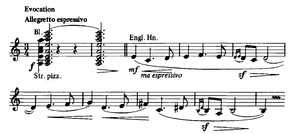Serenades (Brahms)
The two Serenades, Op. 11 and 16, represented two of the earliest efforts by Johannes Brahms to write orchestral music. They both date from the 1850s when Brahms was residing in Detmold.[1]
Brahms had a goal of reaching Beethoven's level in writing symphonies, and worked long and hard on his First Symphony, completing it only in 1876. As preliminary steps in composing for orchestra, he chose early on to write some lighter orchestral pieces, these Serenades.
Serenade No. 1 in D, Op. 11






The first serenade was completed in 1857. At that time, Brahms was also working on his First Piano Concerto. Originally scored for wind and string octet and then expanded into a longer work for chamber nonet, the serenade was later adapted for orchestra;[2][3] Brahms completed the final version for large orchestra in December 1859.[4] In the orchestration of the Concerto Brahms had solicited and got a great deal of advice from his good friend Joseph Joachim. For this Serenade Joachim also gave advice, although to a lesser extent.[5] The first performance of the Serenade, in Hamburg 28 March 1859, "did not go very well" in Brahms's opinion,[6] but evidently the unusually large audience of 1200 overlooked any faults of the performance. At the end applause "persisted until I came out and down in front." After every piece in the concert "the audience was shouting."[6] This was a vastly better reception than the Piano Concerto had in either of its first two performances. But at its third performance, 24 March, also in Hamburg, it had been a success, perhaps not to the same degree as the Serenade.
The Serenade consists of six movements and lasts slightly less than forty minutes.
- Allegro molto (D major)
- Scherzo. Allegro non troppo (D minor) – Trio. Poco più moto (B-flat major)
- Adagio non troppo (B-flat major)
- Menuetto I (G major) – Menuetto II (G minor)
- Scherzo. Allegro (D major) – Trio
- Rondo. Allegro (D major)
Serenade No. 2 in A, Op. 16





The second serenade was written in 1859 and dedicated to Clara Schumann. It was revised in 1875.[7] It is scored for a chamber orchestra, including double woodwinds but omitting violins, trumpets, trombones, and percussion.[7] The five movements take approximately thirty minutes to perform.[8]
- Allegro moderato (A major)
- Scherzo. Vivace (C major) – Trio (F major)
- Adagio non troppo (A minor, ending in A major with a Picardy third)
- Quasi menuetto (D major) – Trio (F-sharp minor)
- Rondo. Allegro (A major)
In 1863 the Vienna Philharmonic was rehearsing a serenade by a young, rather wet-behind-the-ears composer from Hamburg named Brahms. It was a real technical knuckle-buster, and the players complained about the ridiculous difficulty of many of the passages. Why go to all this trouble for a nobody? At the final rehearsal, open mutiny broke out. The first clarinetist stood up and, speaking for all the musicians, declared that they refused to perform the score. Conductor Otto Dessoff, white with anger, laid down his baton and declared his resignation from the Philharmonic. The concertmaster, one of the most celebrated musicians in Vienna, joined him, as well as the equally illustrious first flutist. Alarmed at the threatened disintegration of their orchestra, which, since its foundation by composer and conductor Otto Nicolai, had been in existence for 21 years, the rebels capitulated. The performance of Brahms’ Serenade No. 2 took place as announced and was, to their chagrined astonishment, a tremendous success.
Brahms had written two orchestral serenades in his mid-20s while he was struggling to begin his career as a professional musician in the little city of Detmold, giving piano lessons to the local aristocracy and conducting a small chorus. In September 1859 he sent the score of the second and third movements of the A major Serenade to pianist Clara Schumann (wife of composer Robert Schumann) on her birthday. Clara, with whom Brahms enjoyed a lifelong artistic friendship and (mostly platonic) love affair, wrote back: “What shall I say about the Adagio? I can find no words to express the joy it has given me … I have to try to think of something extremely beautiful, something which gives me the greatest pleasure, perhaps as if I were looking at the stamens of a beautiful flower one by one. It is incredibly beautiful! … My dear Johannes, I’m sure you know that I can feel this better than I can express it in words. The Minuet is very charming (a bit Haydn-ish), and the oboe in the Trio—I look forward to hearing it, it must sound very special with its soaring melody.” These words of encouragement must have been sweetest balm to Brahms, who often was tortured by doubts about the value of his music. Later that spring he wrote to another friend, violinist Joseph Joachim: “I’ve just been arranging my second serenade for piano four hands [four-hand piano arrangements were the most popular form of informal music making and listening in the days before phonograph recordings]. Don’t laugh! I had the greatest joy in it. I have seldom written musical notes with such extreme pleasure. The tones permeated my being so gently and lovingly that I was delighted through and through.”
Notes
- ↑ Geiringer, p. 55
- ↑ Geiringer, pp. 249–250
- ↑ "Program Notes – Last Night of the Brahms". Riverdale Ensemble performance, 2002-11-16.
- ↑ Avins, Styra, Ed. (1997), JOHANNES BRAHMS: Life and Letters, Oxford University Press, ISBN=0-19-816234-0, p. 193, footnote
- ↑ Avins, Ed., p. 180
- ↑ 6.0 6.1 Avins, Ed., p. 193
- ↑ 7.0 7.1 Geiringer, p. 250
- ↑ "Brahms: Symphony No. 3; Serenade No. 2". Amazon.com. Retrieved 2009-06-29. The Haitink LSO recording
References
- Geiringer, Karl (1984). Brahms: His Life and Work – Third Enlarged Edition. New York: Da Capo Press. ISBN 978-0-306-80223-2.